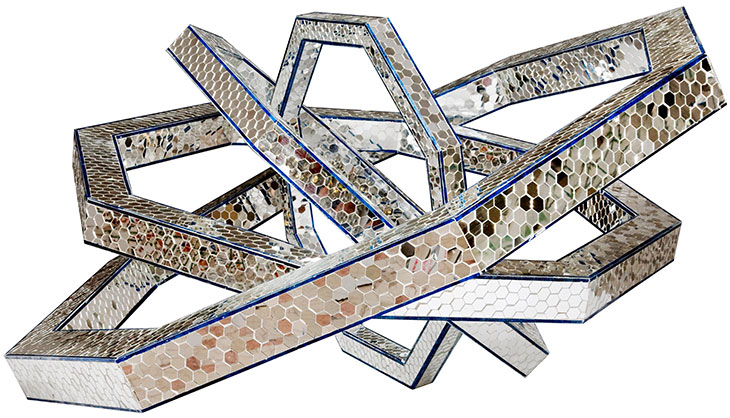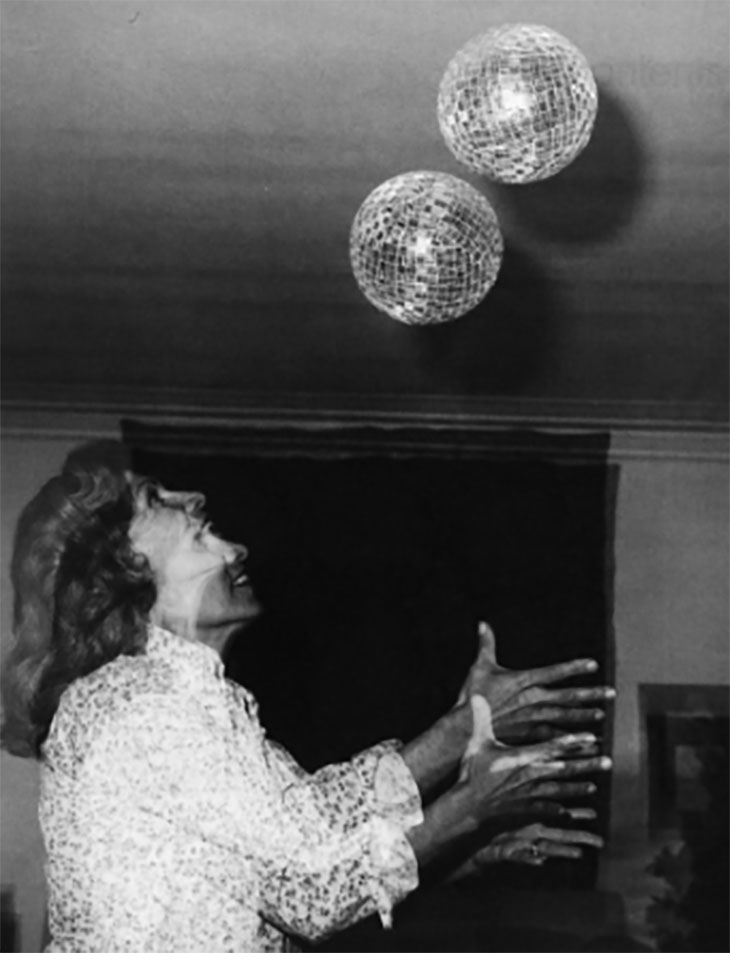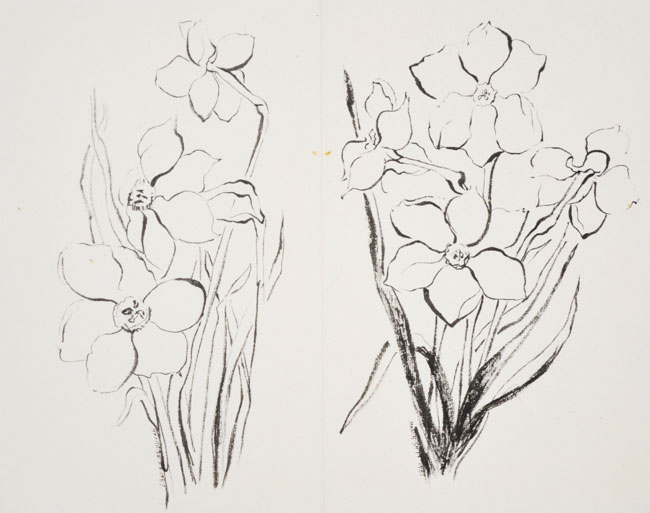I first encountered the work of Monir Shahroudy Farmanfarmaian (1923–2019) at Art Dubai in 2008. It was a moment of fascination for all things developing in the Gulf, spurred in large part by the nascent project to build a Guggenheim Museum in Abu Dhabi. A wave of Western curators descended on the region, seeking to redress the long-standing invisibility in institutional collections of art and artists from the Arab-speaking and Muslim world. All of this was against the backdrop of a post-9/11 homeland security culture of xenophobic self-surveillance. I recall walking through the then-young fair and stopping at the Third Line gallery to look at an unashamedly resolved geometric structure – a hexagon – whose surface was covered in faceted pieces of mirror. Despite the decorative associations of its glittering form, it was defiantly sculptural. Gallerists Claudia Cellini and Sunny Rahbar informed me that this was a work by Monir Farmanfarmaian: ‘She is in her eighties and she’s amazing.’

Octagon (2010), Monir Shahroudy Farmanfarmaian. Courtesy The Third Line
Little did I know then just how amazing Monir was. Over the following decade, I was able to meet her, visit her in Tehran on several occasions, discover and study her work, and learn of her extraordinary life. It was a life of adventure, wonder, separation and survival, one which took her from the holy city of Qazvin, where she was born, to the Iranian capital of Tehran, where she grew up after her father was elected to the parliament in 1932. There was her first stint in New York from the mid 1940s–50s, at the height of American art’s existential awakenings, and again in self-imposed exile after two decades in Tehran due to the rupture of the Islamic revolution. And finally, her return to Tehran in 2004, where she remained for the rest of her life.

Monir Shahroudy Farmanfarmaian with disco balls in the salon of her home in Tehran, 1977. Courtesy The Third Line
This biographical trajectory was accompanied by Monir’s unswerving artistic activity. From her very beginnings as a student, she excelled as a draughtswoman, capable of the most sinuous and freest of lines, a talent she put to use in designs for tapestries, rugs and, during her time at Bonwit Teller in New York in the ’50s, department stores. But it was in the period following her return to Iran in 1957 that she was able to establish herself as an artist in her own right, and to articulate what would become her distinct language: a language of geometry, in which the visual and craft traditions of her country would assume a central role. It is to this period that we owe the so-called ‘mirror works’, reliefs and three-dimensional geometric objects to which were applied tessellated facets of reverse-painted glass and angled mirrors. Inspired by the architecture of holy shrines and mosques, they conveyed also a playful, Pop aesthetic at what might be considered a first moment of a globalised contemporary art world.
During her retreat from the public eye during the ’80s and ’90s in New York, accompanied by the loss of her home and studio and access to the master craftsmen with whom she worked in Iran, Monir continued to make works that were deeply intimate and resourceful. On her return to Tehran at the age of 80, she set about making up for lost time, re-establishing her studio and reconnecting with those of her craftsmen who were still alive. The mirror works produced now were cleaner and more deliberate than ever.

Narges (2) (1987), Monir Shahroudy Farmanfarmaian. Courtesy The Third Line
Drawing remained central to her practice. On one of my first visits to her studio in 2012, Monir pulled out drawer after drawer of graphic works made throughout the 1970s. Intended at the time as working studies for mirror works, these drawings, made with felt-tip pens in blue, yellow, red, green and black, had an elemental dynamism that evoked at once Islamic decorative schema, architectures, and the floating worlds of Persian miniatures. In the final decade of her life, Monir gave a new monumentality to her drawings that matched the ambitious sculptural cycles on which she embarked. Encroaching physical frailty meant that she would have her assistants draw out the essential linear matrices after which she would apply pointillist layers and calligraphic annotations, creating intergalactic constellations and diaphanous veils of line, plane and colour. Ever the prankster, she also began signing some of her drawings Monir Abbasi in reference to the great Safavid painter Reza Abassi, whom she greatly admired as an artist of tradition, who found within the conventions to which he was bound an endless creativity. If geometry was Monir’s convention, it was the visual culture and philosophy of Iran that enabled her to speak of and to the world. From there, she created an art with the power to touch us all.
Suzanne Cotter is director of Mudam Luxembourg–Musée d’Art Moderne Grand-Duc Jean. She curated a survey of Monir Shahroudy Farmanfarmaian’s work at the Serralves Museum of Contemporary Art in 2014, which travelled to the Solomon R. Guggenheim Museum, New York, in 2015.

‘Hers was a life of adventure, wonder, separation and survival’ – on Monir Shahroudy Farmanfarmaian
Monir Shahroudy Farmanfarmaian at the opening of her exhibition at The Third Line, Dubai, in March 2013. Courtesy The Third Line
Share
I first encountered the work of Monir Shahroudy Farmanfarmaian (1923–2019) at Art Dubai in 2008. It was a moment of fascination for all things developing in the Gulf, spurred in large part by the nascent project to build a Guggenheim Museum in Abu Dhabi. A wave of Western curators descended on the region, seeking to redress the long-standing invisibility in institutional collections of art and artists from the Arab-speaking and Muslim world. All of this was against the backdrop of a post-9/11 homeland security culture of xenophobic self-surveillance. I recall walking through the then-young fair and stopping at the Third Line gallery to look at an unashamedly resolved geometric structure – a hexagon – whose surface was covered in faceted pieces of mirror. Despite the decorative associations of its glittering form, it was defiantly sculptural. Gallerists Claudia Cellini and Sunny Rahbar informed me that this was a work by Monir Farmanfarmaian: ‘She is in her eighties and she’s amazing.’
Octagon (2010), Monir Shahroudy Farmanfarmaian. Courtesy The Third Line
Little did I know then just how amazing Monir was. Over the following decade, I was able to meet her, visit her in Tehran on several occasions, discover and study her work, and learn of her extraordinary life. It was a life of adventure, wonder, separation and survival, one which took her from the holy city of Qazvin, where she was born, to the Iranian capital of Tehran, where she grew up after her father was elected to the parliament in 1932. There was her first stint in New York from the mid 1940s–50s, at the height of American art’s existential awakenings, and again in self-imposed exile after two decades in Tehran due to the rupture of the Islamic revolution. And finally, her return to Tehran in 2004, where she remained for the rest of her life.
Monir Shahroudy Farmanfarmaian with disco balls in the salon of her home in Tehran, 1977. Courtesy The Third Line
This biographical trajectory was accompanied by Monir’s unswerving artistic activity. From her very beginnings as a student, she excelled as a draughtswoman, capable of the most sinuous and freest of lines, a talent she put to use in designs for tapestries, rugs and, during her time at Bonwit Teller in New York in the ’50s, department stores. But it was in the period following her return to Iran in 1957 that she was able to establish herself as an artist in her own right, and to articulate what would become her distinct language: a language of geometry, in which the visual and craft traditions of her country would assume a central role. It is to this period that we owe the so-called ‘mirror works’, reliefs and three-dimensional geometric objects to which were applied tessellated facets of reverse-painted glass and angled mirrors. Inspired by the architecture of holy shrines and mosques, they conveyed also a playful, Pop aesthetic at what might be considered a first moment of a globalised contemporary art world.
During her retreat from the public eye during the ’80s and ’90s in New York, accompanied by the loss of her home and studio and access to the master craftsmen with whom she worked in Iran, Monir continued to make works that were deeply intimate and resourceful. On her return to Tehran at the age of 80, she set about making up for lost time, re-establishing her studio and reconnecting with those of her craftsmen who were still alive. The mirror works produced now were cleaner and more deliberate than ever.
Narges (2) (1987), Monir Shahroudy Farmanfarmaian. Courtesy The Third Line
Drawing remained central to her practice. On one of my first visits to her studio in 2012, Monir pulled out drawer after drawer of graphic works made throughout the 1970s. Intended at the time as working studies for mirror works, these drawings, made with felt-tip pens in blue, yellow, red, green and black, had an elemental dynamism that evoked at once Islamic decorative schema, architectures, and the floating worlds of Persian miniatures. In the final decade of her life, Monir gave a new monumentality to her drawings that matched the ambitious sculptural cycles on which she embarked. Encroaching physical frailty meant that she would have her assistants draw out the essential linear matrices after which she would apply pointillist layers and calligraphic annotations, creating intergalactic constellations and diaphanous veils of line, plane and colour. Ever the prankster, she also began signing some of her drawings Monir Abbasi in reference to the great Safavid painter Reza Abassi, whom she greatly admired as an artist of tradition, who found within the conventions to which he was bound an endless creativity. If geometry was Monir’s convention, it was the visual culture and philosophy of Iran that enabled her to speak of and to the world. From there, she created an art with the power to touch us all.
Suzanne Cotter is director of Mudam Luxembourg–Musée d’Art Moderne Grand-Duc Jean. She curated a survey of Monir Shahroudy Farmanfarmaian’s work at the Serralves Museum of Contemporary Art in 2014, which travelled to the Solomon R. Guggenheim Museum, New York, in 2015.
Unlimited access from just $16 every 3 months
Subscribe to get unlimited and exclusive access to the top art stories, interviews and exhibition reviews.
Share
Recommended for you
Michael Wolf (1954–2019)
Art news daily: 26 April
Do volunteers still have a place in museums and cultural organisations?
The Art Fund is disbanding its volunteer network – is the culture sector becoming too professional?
The Apollo 40 under 40 podcast: Russell Tovey
The actor talks to Gabrielle Schwarz about his ‘addiction’ to collecting art – from Tintin to Tracey Emin